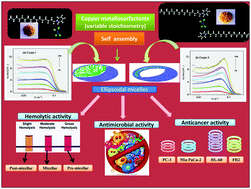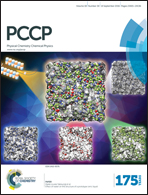Hybrid surfactants decorated with copper ions: aggregation behavior, antimicrobial activity and anti-proliferative effect†
Abstract
In the present study, the emphasis is laid on the self aggregation behavior of copper based inorganic–organic hybrids in aqueous media. The two complexes, cationic hexadecyl pyridinium trichloro cuprate (1 : 1), [Cp]+[CuCl3]−, and bishexadecylpyridinium tetrachloro cuprate (2 : 1), [Cp2]2+[CuCl4]2−, were synthesized using the ligand insertion method. The complexes were characterized using elemental analysis, Fourier transform infrared spectroscopy (FTIR), X-ray diffraction (XRD), nuclear magnetic resonance (NMR) and thermogravimetric analysis. The copper complexes were found to be thermally stable, and in the solid state, they possessed the perovskite arrangement with [Cp2]2+[CuCl4]2− exhibiting superior stability and crystallinity. The self aggregation behavior of the prepared complexes was analyzed in solution phase (in aqueous medium) using surface tension, conductivity, XRD and small angle neutron scattering (SANS). The results show that the presence of copper as a co-ion in both the stoichiometries results in lower critical micellization concentrations than their precursor. Micellization was thermodynamically spontaneous and micelles formed were ellipsoidal in shape and underwent a prolate ellipsoidal growth with an increase in the concentration of metallosurfactant, as estimated from the SANS. Furthermore, these metallosurfactants were investigated for biocompatibility (using hemolytic assay), antimicrobial activity (fungus and bacteria) and cytotoxicity using human cancerous cells. The hemolysis activity was found to depend on the aggregated state of the metallosurfactants, displaying the highest activity in the monomeric state, and the minimum for post micellar concentrations. The surfactants were found to enhance the antibacterial activity by twofold or more, with the addition of metal in both the stoichiometries. On the contrary, for anticancer and antifungal activities, barely any regular trend or generalization could be obtained. Nevertheless, the copper complexes exhibited high IC50 values for fR2 (healthy cells) signifying their higher safety in comparison to the cancerous cells.


 Please wait while we load your content...
Please wait while we load your content...